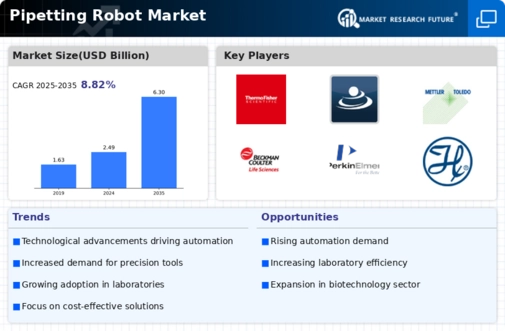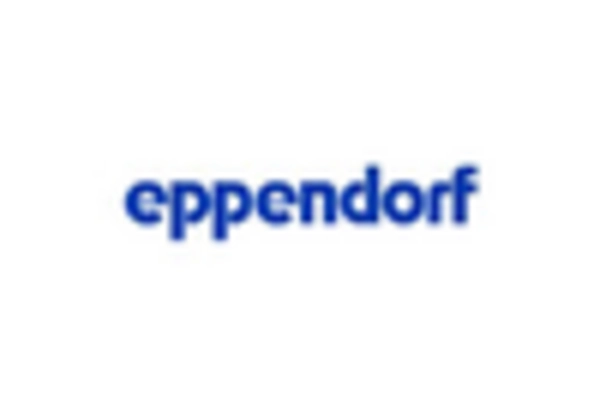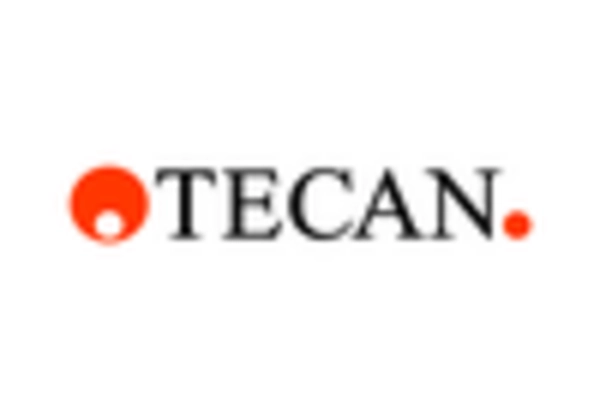Technological Advancements in Robotics
Technological advancements are significantly influencing the Pipetting Robot Market. Innovations in robotics, such as improved motion control and enhanced software capabilities, are enabling pipetting robots to perform complex tasks with greater efficiency. These advancements allow for more precise liquid handling, which is crucial in applications such as genomics and proteomics. Furthermore, the integration of artificial intelligence and machine learning into pipetting systems is expected to enhance their functionality, making them more adaptable to various laboratory environments. As a result, the Pipetting Robot Market is likely to witness an influx of sophisticated robotic solutions that cater to the evolving needs of researchers.
Increased Focus on Laboratory Efficiency
The Pipetting Robot Market is witnessing a heightened focus on laboratory efficiency, driven by the need to optimize workflows and reduce operational costs. Laboratories are increasingly adopting pipetting robots to minimize human error and enhance reproducibility in experiments. This shift is particularly evident in high-stakes environments such as clinical research and diagnostics, where accuracy is paramount. According to recent studies, laboratories that implement automation can achieve up to a 30% reduction in time spent on repetitive tasks. This trend underscores the importance of pipetting robots in streamlining laboratory processes, thereby propelling growth within the Pipetting Robot Market.
Regulatory Compliance and Quality Assurance
Regulatory compliance and quality assurance are becoming increasingly important in the Pipetting Robot Market. Laboratories are required to adhere to stringent regulations regarding accuracy and reproducibility in their processes. As a result, the adoption of pipetting robots is seen as a viable solution to meet these compliance standards. Automated systems not only reduce the risk of human error but also provide consistent results that are essential for regulatory approval. The emphasis on quality assurance is likely to drive the demand for pipetting robots, as laboratories strive to maintain high standards in their research and testing activities.
Rising Demand for High Throughput Screening
The Pipetting Robot Market is experiencing a notable increase in demand for high throughput screening processes. This trend is largely driven by the pharmaceutical and biotechnology sectors, which require rapid and efficient testing of compounds. As research and development activities intensify, laboratories are seeking automation solutions that can handle large volumes of samples with precision. The market for pipetting robots is projected to grow at a compound annual growth rate of approximately 10% over the next five years, reflecting the urgency for faster drug discovery and development. Consequently, the Pipetting Robot Market is adapting to meet these needs, offering advanced systems that enhance throughput while maintaining accuracy.
Growing Investment in Research and Development
Investment in research and development is a key driver for the Pipetting Robot Market. As organizations allocate more resources to R&D, the demand for advanced laboratory automation solutions is expected to rise. This trend is particularly pronounced in sectors such as pharmaceuticals, where the need for innovative drug development is critical. The increasing complexity of biological assays necessitates the use of pipetting robots to ensure accuracy and efficiency. Furthermore, government funding and private sector investments in biotechnology are likely to bolster the Pipetting Robot Market, as more laboratories seek to enhance their capabilities through automation.


















Leave a Comment